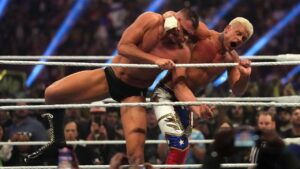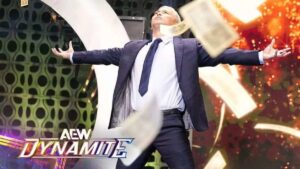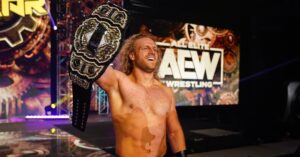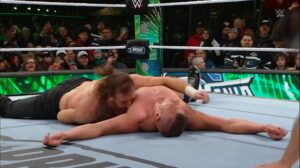It was 10 years ago on Sunday, April 2, 2010, that many wrestling fans found out the horrible news – Chris Kanyon, who competed for ECW, WCW, WWE, and TNA/IMPACT Wrestling, had passed away. What was even more heartbreaking was that Chris’ death was ruled a suicide, as his brother had found his body next to a bottle of antidepressants with an apology note for his actions. Kanyon, who had only retired three years previously in 2007, had struggled for decades as a closeted homosexual, and while it was known within the wrestling industry amongst close friends, it wasn’t until after his release from WWE in 2004 that he finally came out publicly. Sadly, Chris would never get to see the rise of LGBTQ+ wrestlers emerge in the industry he had loved so dearly for much of his life. While sports-entertainers like Chris, Pat Patterson, The Grand Wizard, Terry Garvin, and former AJW World Champion Sandy Parker had all had to keep their sexuality hidden in the shadows, today performers from WWE’s Sonya Deville to AEW Women’s Champion Nyla Rose, from NXT’s Jake Atlas to IMPACT Wrestling‘s Keira Hogan, to indie stars like EFFY, Parrow, Charlie Morgan, and Kris Wolf, have all become stars while being open with their sexuality.

Hailing from Queens, New York, Chris Kanyon first got started in professional wrestling in 1992. In his early forrays into indie wrestling, he tagged with future WCW workmate Billy Kidman in a tag team based around them being hockey players. A year after starting, he soon found himself finding work as an enhancement for the likes of WWF as well as stints with Smokey Mountain Wrestling (SMW) and by 1994, worked for the original ECW. James Mitchell saw promise in the young wrestler and helped further his training by sending him to work with the Wild Samoans and the Fabulous Moolah & Mae Young.

In 1995 he was signed by WCW and for much of the year worked as a low card wrestler on their lesser shows, until he was paired with Mark Starr (ironically his first opponent in WCW in singles action) in the tag team Men At Work, where they dressed like construction workers. Through the spring of 1996, Men At Work fought the likes of The Steiner Brothers, The Road Warriors, The Nasty Boys, and Harlem Heat, but were always fodder for the more popular teams. Following a loss to Harlem Heat on WCW Saturday Night in May of that year, Men At Work were dissolved and Chris Kanyon disappeared from WCW television.

By the end of 1996, Kanyon returned to the road for WCW, but this time under a mask as Mortis. Managed by James Vanderburg, he began feuding with the undefeated Glacier and made his in-ring debut as the masked monster at WCW Uncensored in March 1997. While Mortis would lose to Glacier, that match ended with the debut of Wrath (former WWF Superstar Adam Bomb and future KroniK member Bryan Clark), who helped Mortis beat down Glacier. Mortis and Wrath would became a new tag team and face the likes of Harlem Heat, The Steiner Brothers, Faces of Fear (Meng & The Barbarian) and The Outsiders (Kevin Nash & Scott Hall), but sadly the end result was strikingly similar to the situation Kanyon had experienced in Men At Work – staring up at the lights of the arena. In singles, Mortis faired slightly better – he picked up televised wins over the likes of Juventud Guerrera, Psicosis, and Ernest “The Cat” Miller, and had earned a WCW United States title match against Diamond Dallas Page and WCW World Television title match against Booker T on Monday Nitro. But Mortis had run its course, and following a loss to DDP for the US title once again on WCW Thunder on February 12, 1998, Mortis was taken off television. The match was an initiation for Mortis, who had previously tried to join Raven‘s Flock. Upon failure to do so, he disappeared once again.
Chris Kanyon was once again removed from television and getting set for his next repackaging, which began that summer. He returned unmasked, now known simply as Kanyon, and targeted the Flock for turning him down. He defeated Perry Saturn at WCW/nWo Great American Bash that June and the following night on Nitro defeated Sick Boy. He would then set his sights on Raven himself, and formed a loose alliance with Saturn, who himself had been tossed from the Flock. The new alliance was short-lived, however, and Kanyon finally turned on Saturn and joined Raven’s unit of misfits. Even upon the disbanding of the Flock, Kanyon continued to flank Raven’s side. It was during this run that his famous “Who’s better than Kanyon?” line emerged – which always resulted in the crowd answering “EVERYONE!”. Kanyon would temporarily leave WCW to do work as a stuntman for the Jesse Ventura Story, which came out in 1999.

Chris Kanyon returned to WCW in early 1999 and helped his former Flock mates Raven and Saturn win the WCW World Tag Team titles, before leaving the group to join DDP’s new stable, The Jersey Triad, alongside Bam Bam Bigelow. While the stable was short-lived, dissolving by the summer of 1999, it did afford Kanyon his first title in WCW – the WCW World Tag Team titles. The Triad had a unique clause in their victories, in that all three men were allowed to be utilized during a title defense, in an extension of the Freebirds Rule. Following the disbanding of the Triad, Kanyon returned to stunt work in Hollywood, working on the WCW film, Ready to Rumble.

Upon his return from Hollywood for a second time, he returned as the flamboyant Chris “Champagne” Kanyon, a man who had become accustomed to his Hollywood treatment. He feuded briefly with DDP and Bam Bam, but when Kevin Sullivan took over as booker in late 1999, he was once again removed from TV. In the Spring of 2000, Vince Russo had taken over and Kanyon returned as an ally of DDP, before once again turning on him to join Russo’s New Blood faction. As “Positively” Chris Kanyon (a play on DDP’s Positively Page autobiography which had recently come out), he dyed his hair blonde and feuded with Page once again. He would become one-half of one of WCW’s worst gimmick matches when he faced Buff Bagwell in the Judy Bagwell on a Forklift Match at New Blood Rising that August. Shortly after that match, Kanyon left WCW.
Kanyon ended up re-signing with WCW in early 2001 and returned to feud with DDP, but then something happened – WCW was sold to rivals, WWF. The feud dissolved, but Kanyon was one of the few WCW stars to move over to WWF and debuted that July as part of The Alliance. Shortly after debuting, Alliance manager Stephanie McMahon gave Kanyon the WCW United States Championship that Booker T held. Booker T had won the US title before the WWF purchase, beating Rick Steiner at WCW Greed that March, but who also now possessed the WCW World Heavyweight Championship, having defeated Scott Steiner on the last episode of Nitro. It only took the WWF 20 days to do something WCW never did in six years – give Chris Kanyon a singles title.

Kanyon fended off challenges from Kane, Edge, Essa Rios, and Scotty 2 Hottie in his 46-day reign as US Champion in WWF, before losing it to Tajiri on Raw that September. By then he had already held his second title in WWF – the WWF World Tag Team titles – that he won alongside his on-again-off-again ally/enemy Diamond Dallas Page. The two had defeated the APA (Farooq & Bradshaw) on SmackDown that August (though lost them 12-days later at SummerSlam 2001 to the Brothers of Destruction, The Undertaker & Kane). Sadly, before the Alliance Invasion angle could play out, Kanyon tore his ACL in a dark match against a young Randy Orton. Tragedy would strike again soon after recovery, however. During a reconditioning stint with WWE’s developmental in Ohio Valley Wrestling (OVW) in May of 2002, he injured his shoulder and required further surgery. To make things worse, he suffered an allergic reaction to meds from the surgery and spent weeks in the hospital with fluid in his lungs. It wouldn’t be until February of 2003 that he would return to WWE television. Unfortunately, WWE couldn’t find anything for Kanyon upon his return and after sporadic appearances and piling losses, he was released in February of 2004.
Following his release, he returned to the US indies for the first time since his pre-WCW days, working for various indies in the US and Canada, including an appearance with Pro Wrestling Guerrilla (PWG) at PWG Astonishing Christmas in December 2005 against a pre-King of Dong Style Joey Ryan. That same month, he would make his one and only in-ring appearance for TNA/IMPACT Wrestling, facing his old WCW rival Raven at TNA Turning Point 2005. Following that, his appearances lessened and lessened, retreating home where he would spend his final years working with his hometown New York Wrestling Connection (NYWC). He finally retired from the business for good in 2007.
https://www.youtube.com/watch?v=NbjsM7RDB9o
For decades, as detailed in his autobiography, Wrestling Reality: The Life and Mind of Chris Kanyon, Wrestling’s Gay Superstar (2004), Chris Kanyon, real name Christopher Morgan Klucsarits, fought fierce internal struggles to keep his homosexuality private – from bookers, from other wrestlers, from the fans. During Kanyon’s generation, being openly gay was a death sentence for grapplers, and homosexual-based gimmicks were usually given to straight wrestlers and designed to get “heat” rather than inspire those in the audience who were LGBTQ+ themselves. The lengths he went to conceal his true identity were painstaking and he was sold as something entirely on-screen – during one short-lived angle in WWE, he feuded with Matt Hardy after flirting with Lita.

Chris Kanyon is remembered by many for his brilliant mind for innovation in the ring. He created moves that people had never seen before, inspiring former WCW and TNA announcer Mike Tenay to brand him “The Innovator of Offense” on broadcasts. It’s a tragic shame that a man who loved the industry with every fiber of his being was never given the opportunity to truly inspire in the ring the people he was forced to suppress being a part of – the LGBTQ+ community. Thankfully, thanks to the internet, Kanyon’s legacy will carry on forever, as one of the pioneers of gay wrestlers who sacrificed their own well-being so that gay wrestlers can make their mark. And thankfully, can do so openly without being as shadowed as Chris Kanyon did during his own life and career.
https://twitter.com/TheAtlanticVamp/status/1246181337058459649






